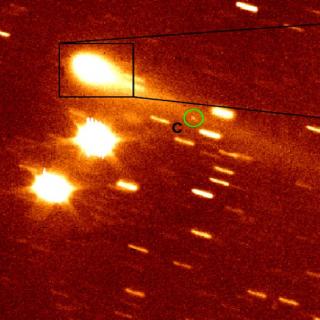Bibcode
Laskar, Tanmoy; van Eerten, Hendrik; Schady, Patricia; Mundell, C. G.; Alexander, Kate D.; Barniol Duran, Rodolfo; Berger, Edo; Bolmer, J.; Chornock, Ryan; Coppejans, Deanne L.; Fong, Wen-fai; Gomboc, Andreja; Jordana-Mitjans, Núria; Kobayashi, Shiho; Margutti, Raffaella; Menten, Karl M.; Sari, Re’em; Yamazaki, Ryo; Lipunov, V. M.; Gorbovskoy, E.; Kornilov, V. G.; Tyurina, N.; Zimnukhov, D.; Podesta, R.; Levato, H.; Buckley, D. A. H.; Tlatov, A.; Rebolo, R.; Serra-Ricart, M.
Bibliographical reference
The Astrophysical Journal
Advertised on:
10
2019
Journal
Citations
52
Refereed citations
48
Description
We present comprehensive multiwavelength radio to X-ray observations of GRB 181201A spanning from ≈150 s to ≈163 days after the burst, comprising the first joint ALMA─VLA─GMRT observations of a gamma-ray burst (GRB) afterglow. The radio and millimeter-band data reveal a distinct signature at ≈3.9 days, which we interpret as reverse-shock (RS) emission. Our observations present the first time that a single radio-frequency spectral energy distribution can be decomposed directly into RS and forward shock (FS) components. We perform detailed modeling of the full multiwavelength data set, using Markov Chain Monte Carlo sampling to construct the joint posterior density function of the underlying physical parameters describing the RS and FS synchrotron emission. We uncover and account for all discovered degeneracies in the model parameters. The joint RS─FS modeling reveals a weakly magnetized (σ ≈ 3 × 10−3), mildly relativistic RS, from which we derive an initial bulk Lorentz factor of Γ0 ≈ 103 for the GRB jet. Our results support the hypothesis that low-density environments are conducive to the observability of RS emission. We compare our observations to other events with strong RS detections and find a likely observational bias selecting for longer lasting, nonrelativistic RSs. We present and begin to address new challenges in modeling posed by the present generation of comprehensive, multifrequency data sets.
Related projects

Small Bodies of the Solar System
This project studies the physical and compositional properties of the so-called minor bodies of the Solar System, that includes asteroids, icy objects, and comets. Of special interest are the trans-neptunian objects (TNOs), including those considered the most distant objects detected so far (Extreme-TNOs or ETNOs); the comets and the comet-asteroid
Julia de
León Cruz